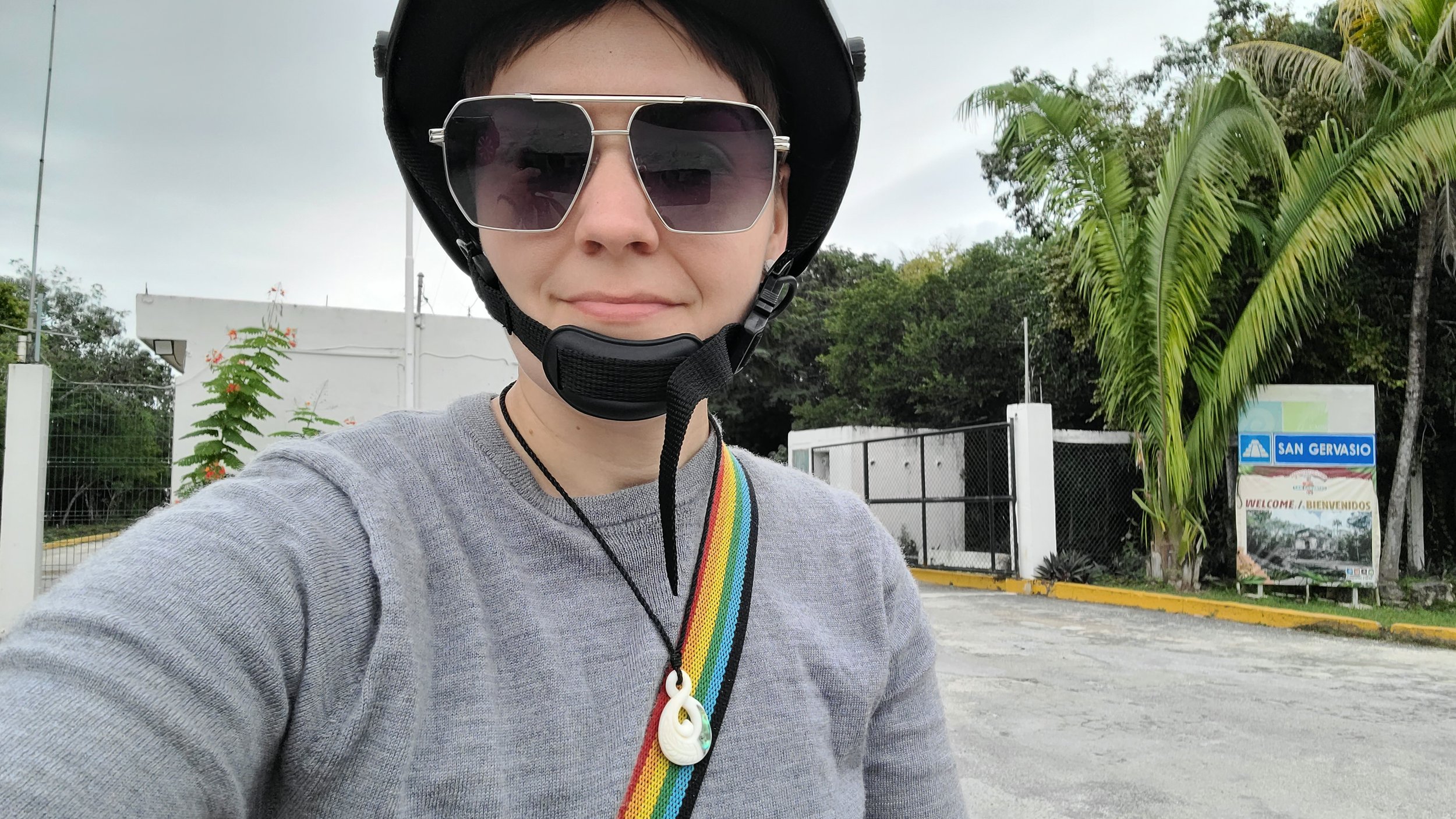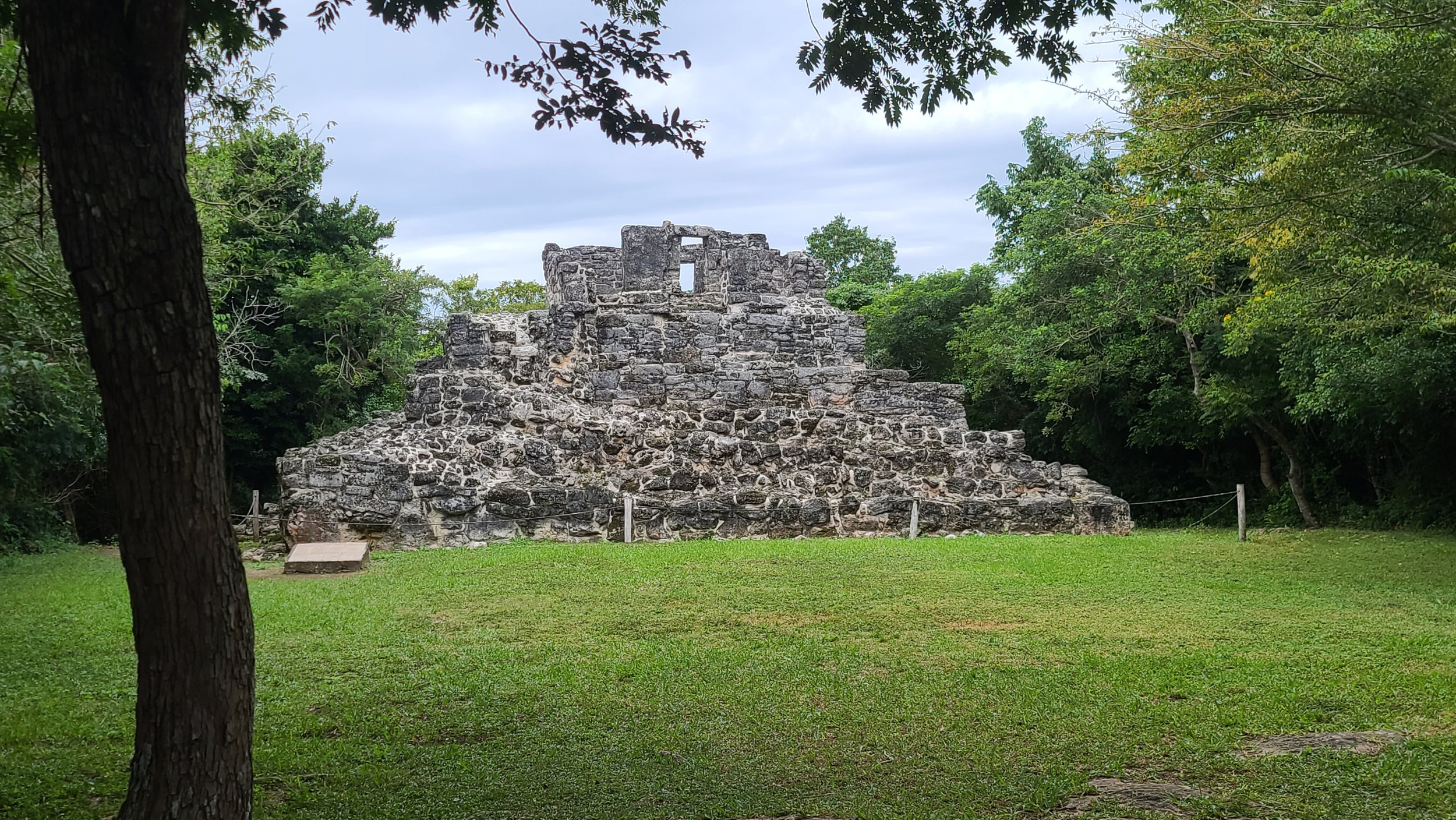Growing up, my father used to talk about the Mayans and their culture all the time. He was a grade school teacher and annually taught a unit all about the Mayans. Despite so much education and awareness of the Mayans all my life, I never actually got to visit or see real Mayan ruins with my own eyes.
As a result, visiting Mayan ruins was a major bucket list item of mine for my first visit to Mexico. So of course I prioritized this for my first full day in Cozumel!
Cozumel has little hints of Mayan remnants all over the island. But there’s really only two places to go see it—El Cedral and San Gervasio. San Gervasio, however, is the most well-preserved and intentional archeological site of the two to see some of the Mayans remaining buildings.
The choice to see it self-guided not only saved me money, it also gave me the opportunity to see it at my own pace and without being herded around with a crowd!
How To Get To San Gervasio?
San Gervasio is a Mayan archaeological site located just 25 minutes southeast of the port of San Miguel in Cozumel, Mexico. The Mayans called it Tantun Cuzamil, which means “Flat Rock in the place of the Swallows.”
Once leaving the city limits, the entrance to get to Tantun Cuzamil is on the left about halfway to the other side of the island along Quintana Roo C-1.
The entrance doesn’t look like much. There is a booth there with a worker posted, but this is not where you pay. They wave you on through and you ride for another 5 minutes down a straight, mostly paved road to reach the parking lot of the site.
You can get to San Gervasio by booking a tour in San Miguel. Alternatively, you can do what I did and hop a scooter and travel there on my own.
There are taxis that will take you there for a fee. I’d expect around $50 for a taxi, as it is a good 25-minute ride from San Miguel’s main port to the archaeological site.
My ride cost me just $17 per day. And it was part of the adventure!
How To Tour San Gervasio?
First of all, there’s a map! This will help guide anyone to the main structures accessible to tourists around San Gervasio.
There are two entrances with separate admission into San Gervasio. In total, I paid $13 just to enter.
Between the two entrances is a courtyard with Mayan style monuments and statues and a whole lot of souvenir shops.
I did get suckered into one of them… but only for a FREE tequlia tasting. The guy almost had me sold on a bottle of their mango tequila! After all, I was here for New Years Eve and this was technically my first full day in Cozumel!
But I decided to pace myself and not get further suckered into buying something. I was here to see Mayan ruins… and this awesome glass gun-shaped tequila bottle, apparently!
At the last entrance, you can pay extra to join a tour group. The guides usually say they are of Mayan descent. I thought this might be a cool option but it was a little more money than I wanted to pay.
I also didn’t feel in the mood for being herded around like cattle.
In the end, I was actually really happy I chose to do a self-guided tour because the groups for the tours were SO BIG (and quite numerous). It was a bit overwhelming even trying to steer clear of them.
I decided to head in the direction of the least number of people first! That helped me find some structures with barely anyone around for optimal photos and just taking in the sites in peace.
I was glad to see signage for each structure explaining its purpose in multiple languages - Spanish, Mayan, and English! I absolutely love that they had the Mayan language represented here to pay respect to the indigenous Mayan descendants and their culture.
All over, there were small signs reminding tourists not to climb on the structures. The stuctures in San Gervasio are from as early as 600 A.D. It’s wild to me that people would climb on these structures.
Note: There were still plenty of pathways and platforms that were ok to walk on—probably rebuilt and not original pathways or structures anymore but they matched the look of the surroundings well. Only these were the ones I stood on or took pictures on top of!
Important Structures Of San Gervasio
The first structure I saw on my own was Las Manitas, or Little Hands right near the entrance. It is named this for its little red-painted hand prints on the inner walls. This was the residence of the halach uinic or leader with his own personal altar inside.
To escape the crowds near this first structure, I shot down a side path to check out Chi Chan Nah, or “Little House.” This structure has an altar at its center so was probably used for ceremonies. The family of the halach uinic most likely used this as a chapel.
Another iconic structure along my path is El Arco, or the Arch. This was reconstructed in 1980, but its iconic because it marks the main entrance to San Gervasio’s District 1 Central Plaza structures. This was a very popular spot for tourists to take photos, so it took a minute for me to get a few once they cleared!
The people in the background are walking alongside what was once the reconstructed “white road” leading from the plaza.
The road ends at a certain point and a dirt pathway leads you through the jungle. It was essentially a mini jungle hike now—leading to different structures found sporadically in clearings between trees.
The next major structure is Nohach Nah, or the Big House. This is one of the best preserved buildings in San Gervasio because of its original roof. Many of the other structures you’ll see around have grass roofs more recently constructed to protect the remaining walls and base of the buildings.
Inside, you can see the colors of a mural that showed the temple’s dedication to the Ku’kul’kan, the feathered serpent god.
This one took some patience to wait for a photo. Of course, it’s always nice to have others around as a solo travel so I can get some nice photos taken! I always return the favor and take photos of couples and families, too!
Another short hike took me along a slightly muddy path to a really interesting structure.
This one is called Los Murcielagos, or The Bats. It’s on a raised platform and includes a few different structures. This was a whole complex for another halach uinic.
I wondered if the door size was accurate—how little were the Mayans?
Inside the building there are two rooms including an altar.
On the same compound is Pet Nah, or Round Building, which has 2 circular platforms and an altar.
Possibly the most famous building in San Gervasio is Ka’na Nah, or Tall House. This is a pyramid-like structure once had human faces carved into the steps. Archaeologists believe it was dedicated to Ixchel, considered the Goddess of fertility and death.
It looks really tall and impressive from far away. Up close, with me standing in front of it, it somehow shrinks a bit in perspective! But I really did like this one and on the other side there were very clear stairs that go up to the altar at the top.
On my way back from the pyramid, it became clear that all roads connect to a central plaza.
There are 8 of the most important structures in San Gervasio immediately encircling this plaza, which has an altar at its center. In addition to the Altar, the plaza is made up of The Palace, The Osuary, Structure 25B, The Niches Building, The Columns, The Fit Tree Building, and The Murals.
I was surprised to see they allowed people to get up on top of the altar—it must be another reconstruction and not original.
The Way Out
I finished after about 2 hours of exploring all of the major buildings and hiking the whole area.
From the plaza area, I took the pathway made for tourists that carved its way across manicured grass alongside a reconstructed, but original placement of the road through San Gervasio. It was neat to imagine such a road here so long ago.
Reaching the entrance, a familiar creature met me to see me out—a coati! The first time I saw a coati was in the jungle of the Osa Peninsula in Costa Rica! How fun to see one again here in Mexico.
A lot of tourists spotted the coati, too, but many didn’t know what it was. This was one of those moments that I appreciated the education I received on a paid tour I chose to take. But sometimes, it’s not as worth it to me!
In Conclusion
San Gervasio was the perfect place for a self-guided tour of Mayan Ruins in Mexico. I was able to mostly avoid the large crowds and go at my own pace. I enjoyed the small hike I got out of the experience as I trekked from building to building around the whole archeological site.
This was definitely a unique experience on Cozumel—there aren’t many other places that have this level of historic relevance and significance and preservation of Mayan culture. I highly recommend hopping on a scooter and checking it out on your own, especially if you will be in Cozumel for a few days.














































